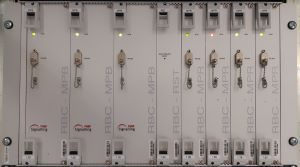AURIGA TS is the ATP trackside solution based on ETCS standard specifications.
Using cutting-edge technologies, AURIGA TS is able to be integrated in large, scalable and interoperable ERTMS solutions, while achieving highest levels of availability in safety critical operations, satisfying all kind of functional requirements in each of the possible ETCS levels.
TECHNICAL FEATURES
Safety
AURIGA TS from CAF Signalling fulfil CENELEC 50126, 50128 & 50129 standards, achieving a Safety Integrity Level 4 (SIL4).
Availability
Main components of AURIGA TS solution rely on the safety HW platform from CAF Signalling with a 2oo3 architecture, providing a high availability and fault tolerance on each and every ETCS level.
Functionality and System Versions
AURIGA TS offers ERTMS specification functionalities from Baseline 2 and Baseline 3 (R2). Most of those functionalities are configurable, allowing more flexible settings and fitting every kind of engineering rules and deployments needs easily.
Temporary Speed Restrictions
Optionally, the TSR subsystem can be integrated in AURIGA TS, allowing the deployment of Temporary Speed Restrictions (TSR) within the boundaries of the line. Commanded at Control Centre level, the TSR are distributed dynamically, allowing precisions of one meter and speeds in multiples of 5 km/h. TSRs are synchronized in coordination with all available ETCS levels.
Products & ETCS Levels
AURIGA TS provides different NoBo certified interoperable constituents for the different ETCS levels and required functionalities, being L1EM (Level 1 ERTMS Manager) and LEU for level 1, and RBC for levels 2 and 3 the most relevant among them.
AURIGA L1
AURIGA L1 uses Eurobalises to communicate with the train, which receives movement authority information, ETCS profiles and all related track conditions. This information is processed by the ETCS on-board unit (e.g. AURIGA OBS) to perform the correct braking curves management and speed supervision. Possible configurations are:
- Centralised LEU, connected to L1EM which decides the active telegram in every balise.
- Remote LEU, placed in wayside tracks, using digital I/O or communications to select the telegrams.
AURIGA L2
AURIGA L2 uses RBC as the core element of the solution. The RBC integrates an RDSI E1 interface to communicate with GSM-R networks, avoiding the use of external multiplexing devices. Alternatively, RBC is ready to communicate using newest radio communication technologies (e.g. LTE).
AURIGA L3
Using an equipment deployment similar to L2, AURIGA L3 reduces the number of field elements to be installed wayside, increasing dramatically the available capacity by using the fix virtual block or moving block concepts. Train integrity monitoring system installed on board is needed to enable this solution.

BENEFICTS/ADVANTAGES
Interoperability
As UNISIG Full Member, CAF Signalling has proved the interoperability of its ETCS solutions with ETCS systems from other suppliers. Thus, AURIGA L1/L2/L3 is capable to operate with AURIGA OBS or any other on-board ETCS from a certified supplier. Similarly, AURIGA OBS is able to operate in tracks equipped with certified trackside ETCS systems from other manufacturers.
Optimized maintenance
Maintenance System (SAM) offered by CAF Signalling is integrated in all AURIGA TS levels, enabling the use of a comprehensive set of tools for diagnosis and alarm detection.
Engineering tools, test & simulation
Being ETCS data preparation a complex process, CAF Signalling has developed an advanced set of tools for engineering design and creation of specific configuration data suitable for products up to SIL 4, and reducing the costs of testing and commissioning by automating the tests (most of them performed in lab) needed in signalling projects.
Licensed Equipment Supplier
 Download data sheet:
Download data sheet: 
